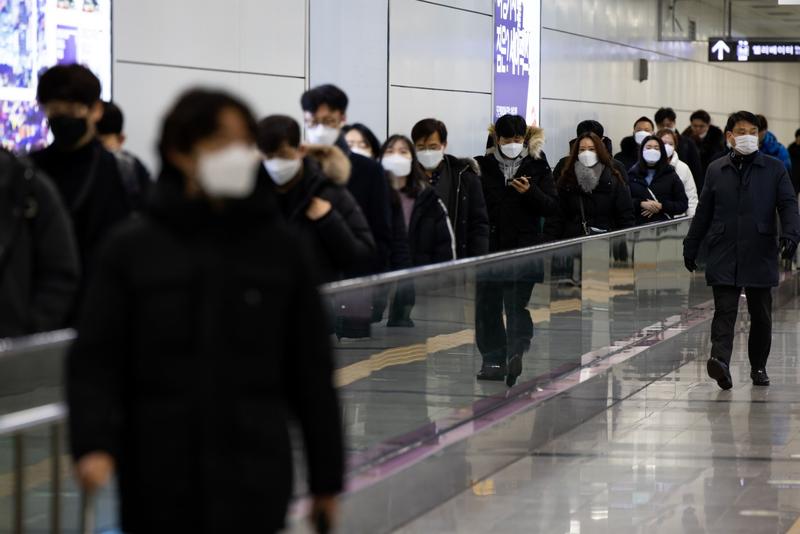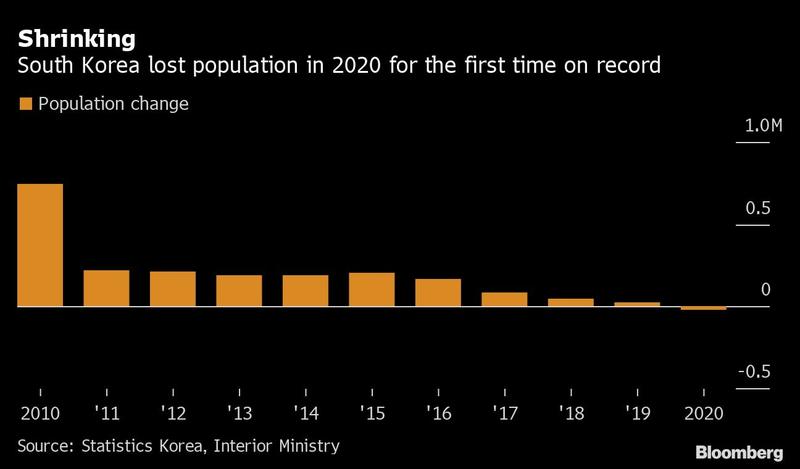 Passengers wearing protective masks walk on a moving walkway at a subway station in Seoul, South Korea, on Monday, Dec 14, 2020.
Passengers wearing protective masks walk on a moving walkway at a subway station in Seoul, South Korea, on Monday, Dec 14, 2020.
South Korea’s population declined in 2020 for the first time on record as births dropped to a historic low amid the pandemic.
The population fell by about 21,000 to 51.8 million, according to the Ministry of Interior and Safety. The number of South Korean births slid 11 percent compared with the previous year, likely driving down what is already the world’s lowest national fertility rate.
With the pandemic hitting jobs and hurting incomes, even more people are delaying marriage and pregnancies, accelerating the country’s aging problems, the Bank of Korea said in a report last month.
South Korean policy makers for years have had little success trying to boost birth rates by subsidizing pay during childcare leave and providing free nurseries. A lack of good jobs is the big reason that young people are choosing to have fewer babies, according to Sung Tae-yoon, an economics professor at Seoul’s Yonsei University.
The population fell by about 21,000 to 51.8 million, according to the Ministry of Interior and Safety. The number of South Korean births slid 11 percent compared with the previous year, likely driving down what is already the world’s lowest national fertility rate
ALSO READ: South Korea expands ban on social gatherings nationwide
With the pandemic hitting jobs and hurting incomes, even more people are delaying marriage and pregnancies, accelerating the country’s aging problems, the Bank of Korea said in a report last month.
South Korean policy makers for years have had little success trying to boost birth rates by subsidizing pay during childcare leave and providing free nurseries. A lack of good jobs is the big reason that young people are choosing to have fewer babies, according to Sung Tae-yoon, an economics professor at Seoul’s Yonsei University.
“The economy isn’t growing as fast as it used to, and the rigid wage system that rewards employees for seniority keeps employers reluctant to hire new ones,” he said.
The jobless rate for South Koreans in their 20s exceeds 9 percent, even as the figure for all age groups hovers around 4 percent.
The interior ministry’s report, released Sunday, also showed households getting smaller, shrinking to an average of just 2.24 people. People living alone now account for close to 40 percent of the total, suggesting that the focus of welfare and housing policies needs to change, the report said.

READ MORE: South Korea faces symptoms of drop in male population
With seniors aged 60 and older now making up 24 percent of the population and the number of working-age people continuing to decline, government finances are likely to come under increasing pressure, especially given all the spending needed to deal with the pandemic.
South Korea’s government still has a low debt-ratio compared with other developed economies, but the pace of increase has alarmed some policy makers and President Moon Jae-in’s administration is pushing for legislation to cap borrowing.


